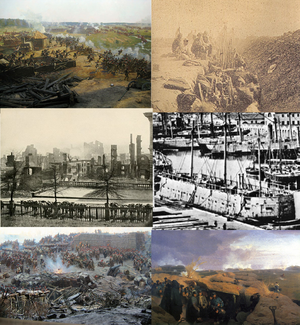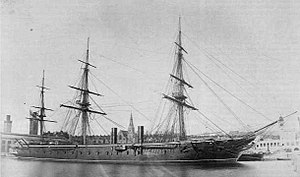Carlosian War: Difference between revisions
No edit summary |
|||
| Line 26: | Line 26: | ||
* {{flagicon|The Vale}} [[The Vale|The Crowned Republic of the Vale]] (1868-1871) | * {{flagicon|The Vale}} [[The Vale|The Crowned Republic of the Vale]] (1868-1871) | ||
| combatant2 = | | combatant2 = | ||
* {{flagicon|Valden}} [[Valden|The Principality of Valden]] (1866-1872) | * {{flagicon|Valden}} [[Valden|The Grand Principality of Valden]] (1866-1872) | ||
* {{flagicon|Trelein}} [[Capisaria|The Divine Imperium of Trelein]] (1865; 1868-1872) | * {{flagicon|Trelein}} [[Capisaria|The Divine Imperium of Trelein]] (1865; 1868-1872) | ||
* {{flagicon|Sumaväa}} [[Finorskia|The Republic Sumaaväa]] (1868-1872) | * {{flagicon|Sumaväa}} [[Finorskia|The Republic Sumaaväa]] (1868-1872) | ||
Revision as of 11:43, 12 June 2019
| The Carlosian War | |||||||||
|---|---|---|---|---|---|---|---|---|---|
 Clockwise from Top Right: Treleini soldiers entrenched outside the city of Matanzas, a Valden ironcland under construction in Roslinburg, the Valian Expeditionary Brigade near Leeds, the 52nd Del Marva Regiment at the battle of Fort Naranja, the Ruins of Weissburg after the evacuation and looting of the city, The Verdean 10th Regiment of Regulars at the battle of Regenstadt Heights. | |||||||||
| |||||||||
| Belligerents | |||||||||
|
| ||||||||
| Commanders and leaders | |||||||||
| Strength | |||||||||
|
Initial Strength
Total Manpower 11,785,934 |
Initial Strength
Total Manpower | ||||||||
| Casualties and losses | |||||||||
|
13,000,515
|
8,667,168
| ||||||||
| Triple Pact statistics do not consider civilian losses in their casualty statistics; modern estimates place the number of civilian deaths of Triple Pact nations in the Carlosian War at roughly 1.71 million. | |||||||||
This article is incomplete because it is pending further input from participants, or it is a work-in-progress by one author. Please comment on this article's talk page to share your input, comments and questions. Note: To contribute to this article, you may need to seek help from the author(s) of this page. |
The Carlosian War (Verdean La Guerra de Emperador Carlos, Isarléan Le Guerre d'Empereur Charles, Valdens Der Karlkrieg), also known as the First Meridonian Great War, was a seven year and one month long war fought between the Isarlo-Verdean Alliance, led by the Second Verdean Empire and the Triple Pact of Trelein, Valden, and Sumaaväa, over several territories along the coastline of eastern Meridon, most notably, the provinces of San Lumen, and Roslinburg, which were historically Verdean colonies taken over by the mainland powers during the Imperial Period, but that the First Verdean Empire, and successor regimes never ceded claim to. The conflict was immediately sparked by the sabre-rattling declaration of intent to retake lost territories, made by Verdean Emperor Carlos XII Parisa, and the subsequent invasion of Treleini San Lumen.
On May 6th, 1865, The Verdean Imperial Navy formally declared war on the Divine Imperium of Trelein, preparing an invasion of San Lumen twenty days later. The Verdeans unleashed a number of secret weapons during the opening phases of the war, devastating the outdated Treleini military, and quickly seizing victory over Trelein over the course of a few months.
The Verdean Empire subsequently invaded Valden which proved a more lasting conflict; with campaigning in Valden proper lasting nearly three years, before the capital; Weissburg was seized. The Valdens however, refused to surrender, even as the Verdeans launched their ill fated first invasion of Borealés del Norte, then the Sumaaväan capital of Viime Satama. Coupled with the re-entry of Trelein into the war with their new puppet state of Los Cuarzos, as well as the alliance between Isarlé and Verde the war entered it's second phase; as the two alliances fought the bloodiest battles of the war.
The turning point of the war ultimately came with the disastrous failure of the second invasion of Sumaaväa, and the near complete destruction of the entire army sent to take Viime Satama; with the collapse of that front, and the freeing up of Sumaaväan reserves; 1870 and 1871 saw the complete collapse of the fronts in mainland Meridon, and exit of Isarlé and the Vale from the War; and after the campaign to liberate Los Cuarzos; the death of Emperor Carlos XII, and some campaigning in the Verdean Archipelago proper, the war was end by an armistice on the 31st of December (52 de Mesvacío) of 1871 (DI 71), with the conflict formally coming to a conclusion with the Treaty of Corazón del Río the following year.
The Carlosian War saw the dramatic re-balancing of power in Meridon; with the Verdeans permanently losing their claims to the Mainland, and losing power and influence more generally; seeing the modernization Trelein, paving the way for Capisarian re-unification a few decades later; and establishing Valden became the preeminent continental power until the end of the Valden War in the 1930s.
Causes
The causes of the Carlosian War were rooted firmly in the slow decline of the First Verdean Empire during the Imperial Period, the birth of Nationalism, and growing anxiety about the loss of influence and economic might to the mainland powers. The newly crowned Emperor of the Second Empire, promised a restoration of Verdean power and glory, by seizing historically claimed territories, occupied by mainland powers, and humiliating and weakening said powers, thus re-establishing Verdean hegemony over the entirety of Greater Meridon. On the other side, a number of the Triple Pact powers were among the ascendant Meridonian nations, with the Valdens in particular seeking establish themselves as a major regional power after their empire broke up in the Liberal Revolutions of the late 18th century; and the Divine Imperium of Trelein, as well as the Republic of Isarlé which were in conflict over the nature of Capisarian culture, and both sought, to some extent the re-establishment of the Capisarian Empire. The growth of nationalist sentiment in many of the warring nations made a major conflict in Meridon largely inevitable in the eyes of contemporary and modern scholars, and re-establishment of the Verdean Monarchy by such a militant personality as Carlos XII was simply the spark to start the conflict.
Prelude
The fall of the Imperial Administration in the Verdean Revolution, led to the short lived Verdean First Republic. The Imperial colony of Los Cuarzos seceded shortly afterwards, forming the Cuarzan Confederacy, a move which the Republic, still in chaos, could not react to. Over the next few decades, the Republic struggled to maintain a balance of power between the various factions of Verde, with growing instability resulting in the end of democracy with the election of the Unity Party, and the establishment of the year long Directorate, whose brutality and corruption led to the "Quiet Coup" of Emperor Carlos Parisa, a young military officer in 1850 (DI 50), and the establishment of the Second Verdean Empire.
The newly crowned Emperor Carlos XII, upon coming to power promised a restoration of Verdean glory, and the re-establishment of Verdean hegemony over the whole of Greater Meridon, immediately embarking on a campaign of military re-armament, reorganization and modernization. Many Meridonian nations responded with concern; with Isarlé in particular worrying for the future of peace in Meridon. Nations such as Valden on the other hand, saw Verdean saber rattling as a chance to similarly build up military strength, with the resulting industrial boom rapidly building up armaments production throughout the region, as well as increasing the strength of standing armies. The Treleinis on the other hand refused to modernize their army, believing that their strength would come through faith rather than technology.
Carlos XII established the first modern system of conscription in 1853, replacing the outmoded model of levying as a means of mass recruitment. Similarly a major naval rearmament program commenced with dozens of new steamships replacing the sailing ships of the standing Republican Navy, culminating with the commissioning of the new flagship Corazón del Río, a 150 gun super battleship of the line. Similarly, the reorganization of the Verdean Army was completed, along with new tactics and strategies developed during the intervening years. All of which were in preparation for the first act of aggression made by Carlos Parisa.
The Verdean Empire would have a chance to test out its new model military when in 1859 (DI 59), the Second Empire invaded the Cuarzan Confederacy, and overpowered the much smaller nation with little effort. The invasion was met with condemnation by many Meridonian nations, however, few were willing to push their objection beyond words, even as the Cuarzan government fled to Trelein with the intent to someday reclaim their homeland. The invasion did, however cause Sumaaväa, and other Meridonian nations to better prepare for war.
After the Verdean Invasion of Los Cuarzos, the Imperial Military underwent further modernizations integrating new technologies notably early bolt-action, and tubular magazine, rifles, steel breech loading cannon, as well as secretly completing the Bestio Ferro class of ironclad warships, which were never before seen in Meridon. Changes to tactics also followed the invasion, as well as updates to mobilization time tables, and transport plans to maximize speed of mobilization. Similar developments would occur among the Valdens, though not to the same extent.
The final prelude to war came in early 1865 (DI 65), when Carlos XII made his famous "Verde Irredenta" declaration, essentially stating his will to press the Imperial claim to its lost colonies. The Isarléans made a desperate attempt to seek a peaceful resolution to the conflict. The Verdeans would make limited overtures to peacefully annex the territories, even as they secretly mobilized their army, and prepared for the invasion of San Lumen. As these offers would be flatly rejected, which was expected, final preparations for war were made.
Opposing Forces
The Isarlo-Verdean Alliance
Before the war, the Verdean Imperial Navy was the preeminent military force in Greater Meridon, with several ironclads, modernized artillery, a fleet over two hundred strong, and the largest effective warship in the region, the Corazón del Río. Working closely with the Navy, the Imperial Marines was similarly a formidable force, standing over one hundred thousand strong well trained, and equipped with early models of bolt-action, tube magazine rifles, as well as modern artillery, and led by several capable commanders, most notably General del Mar Luciano Ruíz Contreras. The army was the largest force in the Verdean military, standing at roughly four hundred thousand strong, with vast reserves, equipped with fairly modern equipment. At the outbreak of the war, the Verdean Empire maintained the strongest single military force in Greater Meridon, and among its best led.
Isarlé's peacetime army was comparatively small, professional force backed by a pool of conscripted reservists having replaced traditional levée systems with conscription shortly after its adoption by the Second Empire. The new conscription system was not, however, tested by conflict, and mobilization timetables and standing orders were lacking, meaning that the professional force would have to wait for an extensive period of time before reservists could assist them in the defense of the nation. They were however, fairly well equipped with modern weapons, and often supported with training from experienced foreign offices. The Isarléan Navy was fairly sizable, but dwarfed by its ally in this respect, possessing several dozen steamships. Isarlé also maintained an alliance with the Crowned Republic of The Vale, though the Valian military was quite small, and they sent only a single Brigade to fight in the Carlosian War under the command of Isarléan generals.



